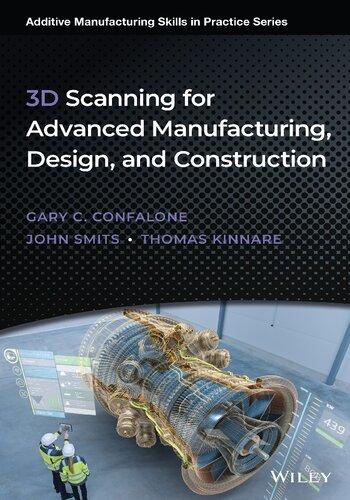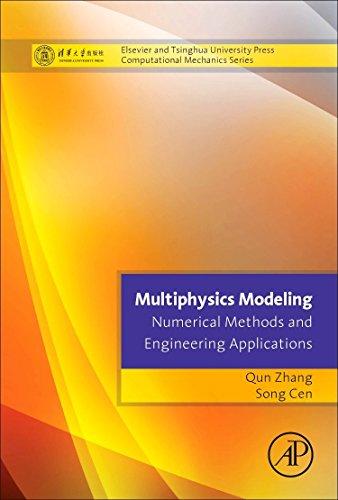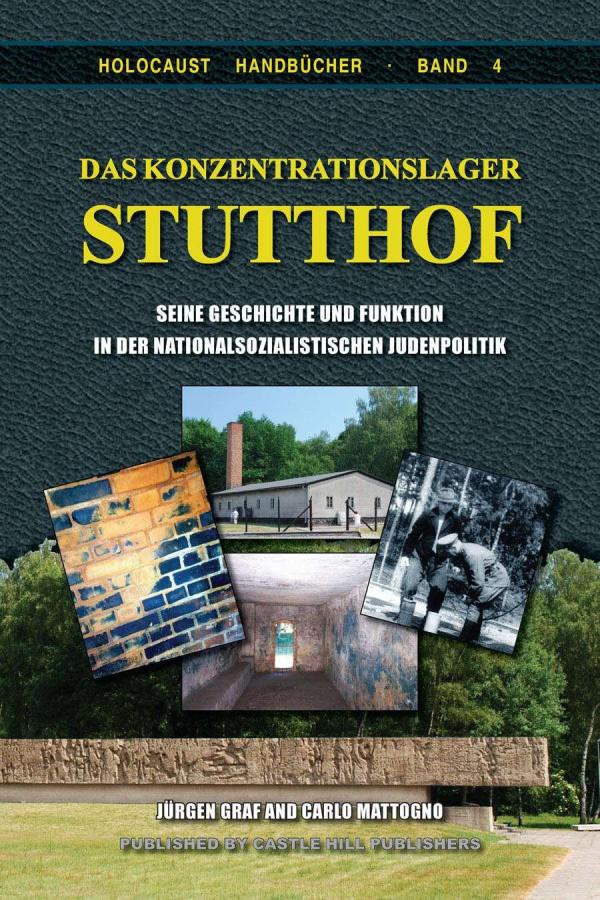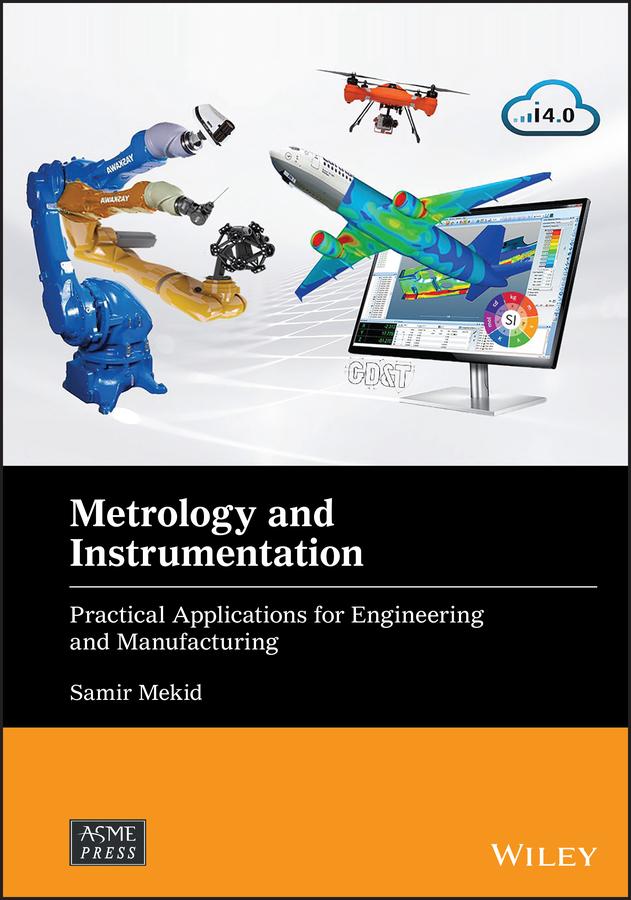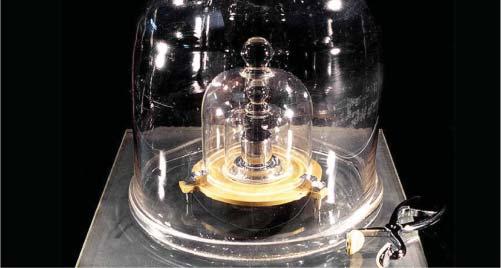MetrologyandInstrumentation:Practical ApplicationsforEngineeringandManufacturing (Wiley-ASMEPressSeries)1stEditionSamirMekid
https://ebookmass.com/product/metrology-and-instrumentationpractical-applications-for-engineering-and-manufacturingwiley-asme-press-series-1st-edition-samir-mekid/
Instant digital products (PDF, ePub, MOBI) ready for you
Download now and discover formats that fit your needs...
3D Scanning for Advanced Manufacturing, Design, and Construction: Metrology for Advanced Manufacturing Gary C. Confalone
https://ebookmass.com/product/3d-scanning-for-advanced-manufacturingdesign-and-construction-metrology-for-advanced-manufacturing-gary-cconfalone/ ebookmass.com
Multiphysics Modeling: Numerical Methods and Engineering
Applications: Tsinghua University Press Computational Mechanics Series 1st Edition Cen
https://ebookmass.com/product/multiphysics-modeling-numerical-methodsand-engineering-applications-tsinghua-university-press-computationalmechanics-series-1st-edition-cen/
ebookmass.com
978-1118961940 Geothermal Heat Pump and Heat Engine Systems: Theory And Practice (Wiley-ASME Press Series)
https://ebookmass.com/product/978-1118961940-geothermal-heat-pump-andheat-engine-systems-theory-and-practice-wiley-asme-press-series/
ebookmass.com
Comparative international law Roberts
https://ebookmass.com/product/comparative-international-law-roberts/
ebookmass.com
The US Navy and the National Security Establishment: A Critical Assessment John T. Hanley
https://ebookmass.com/product/the-us-navy-and-the-national-securityestablishment-a-critical-assessment-john-t-hanley/
ebookmass.com
A Politics of Melancholia George Edmondson
https://ebookmass.com/product/a-politics-of-melancholia-georgeedmondson/
ebookmass.com
The Timid Tiger: M/M Mpreg Shifter Romance (Male-Order Mates Book 8) Lorelei M. Hart
https://ebookmass.com/product/the-timid-tiger-m-m-mpreg-shifterromance-male-order-mates-book-8-lorelei-m-hart/
ebookmass.com
Konzentrationslager Stutthof 2nd Edition Jürgen Graf
https://ebookmass.com/product/konzentrationslager-stutthof-2ndedition-jurgen-graf/
ebookmass.com
Redemption: Dark Romance Jordyn Ellery
https://ebookmass.com/product/redemption-dark-romance-jordyn-ellery/
ebookmass.com
Applied Partial Differential Equations (Undergraduate Texts in Mathematics) 3rd Edition, (Ebook PDF)
https://ebookmass.com/product/applied-partial-differential-equationsundergraduate-texts-in-mathematics-3rd-edition-ebook-pdf/
ebookmass.com
MetrologyandInstrumentation
Wiley-ASMEPressSeries
FabricationofProcessEquipment
OwenGreulich,MaanH.Jawad
EngineeringPracticewithOilfieldandDrilling Applications
DonaldW.Dareing
Flow-InducedVibrationHandbookforNuclear andProcessEquipment
MichelJ.Pettigrew,ColetteE.Taylor, NigelJ.Fisher
VibrationsofLinearPiezostructures
AndrewJ.Kurdila,PabloA.Tarazaga
BearingDynamicCoefficientsinRotordynamics: ComputationMethodsandPracticalApplications
LukaszBrenkacz
AdvancedMultifunctionalLightweight Aerostructures:Design,Development,and Implementation
KamranBehdinan,RasoolMoradi-Dastjerdi
VibrationAssistedMachining:Theory,Modelling andApplications
Li-RongZheng,Dr.WanqunChen,DehongHuo
Two-PhaseHeatTransfer MirzaMohammedShah
ComputerVisionforStructuralDynamicsand HealthMonitoring
DongmingFeng,MariaQFeng
TheoryofSolid-PropellantNonsteady Combustion
VasilyB.Novozhilov,BorisV.Novozhilov
IntroductiontoPlasticsEngineering
VijayK.Stokes
FundamentalsofHeatEngines:Reciprocating andGasTurbineInternalCombustionEngines JamilGhojel
OffshoreCompliantPlatforms:Analysis,Design, andExperimentalStudies
SrinivasanChandrasekaran,R.Nagavinothini
ComputerAidedDesignandManufacturing ZhumingBi,XiaoqinWang
PumpsandCompressors MarcBorremans
CorrosionandMaterialsinHydrocarbon Production:ACompendiumofOperationaland EngineeringAspects
BijanKermaniandDonHarrop
DesignandAnalysisofCentrifugalCompressors ReneVandenBraembussche
CaseStudiesinFluidMechanicswithSensitivities toGoverningVariables
M.KemalAtesmen
TheMonteCarloRay-TraceMethodinRadiation HeatTransferandAppliedOptics
J.RobertMahan
DynamicsofParticlesandRigidBodies: ASelf-LearningApproach MohammedF.Daqaq
PrimeronEngineeringStandards,Expanded TextbookEdition
MaanH.JawadandOwenR.Greulich
EngineeringOptimization:Applications,Methods andAnalysis
R.RussellRhinehart
CompactHeatExchangers:Analysis,Designand OptimizationusingFEMandCFDApproach C.Ranganayakuluand KankanhalliN.Seetharamu
RobustAdaptiveControlforFractional-Order SystemswithDisturbanceandSaturation MouChen,ShuyiShao,andPengShi
RobotManipulatorRedundancyResolution YunongZhangandLongJin
StressinASMEPressureVessels,Boilers,and NuclearComponents
MaanH.Jawad
CombinedCooling,Heating,andPowerSystems: Modeling,Optimization,andOperation YangShi,MingxiLiu,andFangFang
ApplicationsofMathematicalHeatTransferand FluidFlowModelsinEngineeringandMedicine AbramS.Dorfman
BioprocessingPipingandEquipmentDesign:A CompanionGuidefortheASMEBPEStandard WilliamM.(Bill)Huitt
NonlinearRegressionModelingforEngineering Applications:Modeling,ModelValidation,and EnablingDesignofExperiments
R.RussellRhinehart
GeothermalHeatPumpandHeatEngine Systems:TheoryandPractice
AndrewD.Chiasson
FundamentalsofMechanicalVibrations Liang-WuCai
IntroductiontoDynamicsandControlin MechanicalEngineeringSystems ChoW.S.To
MetrologyandInstrumentation
PracticalApplicationsforEngineeringandManufacturing
SamirMekid
KingFahdUniversityofPetroleum&Minerals
Dhahran,SaudiArabia
Thiseditionfirstpublished2022 ©2022JohnWiley&Sons,Inc.
ThisWorkisaco-publicationbetweenJohnWiley&Sons,Inc.andASMEPress.
Allrightsreserved.Nopartofthispublicationmaybereproduced,storedinaretrievalsystem,ortransmitted,inany formorbyanymeans,electronic,mechanical,photocopying,recordingorotherwise,exceptaspermittedbylaw. Adviceonhowtoobtainpermissiontoreusematerialfromthistitleisavailableathttp://www.wiley.com/go/ permissions.
TherightofSamirMekidtobeidentifiedastheauthorofthisworkhasbeenassertedinaccordancewithlaw.
RegisteredOffice
JohnWiley&Sons,Inc.,111RiverStreet,Hoboken,NJ07030,USA
EditorialOffice 111RiverStreet,Hoboken,NJ07030,USA
Fordetailsofourglobaleditorialoffices,customerservices,andmoreinformationaboutWileyproductsvisitusat www.wiley.com.
Wileyalsopublishesitsbooksinavarietyofelectronicformatsandbyprint-on-demand.Somecontentthatappears instandardprintversionsofthisbookmaynotbeavailableinotherformats.
LimitofLiability/DisclaimerofWarranty
Thecontentsofthisworkareintendedtofurthergeneralscientificresearch,understanding,anddiscussiononly andarenotintendedandshouldnotberelieduponasrecommendingorpromotingscientificmethod,diagnosis,or treatmentbyphysiciansforanyparticularpatient.Inviewofongoingresearch,equipmentmodifications,changes ingovernmentalregulations,andtheconstantflowofinformationrelatingtotheuseofmedicines,equipment,and devices,thereaderisurgedtoreviewandevaluatetheinformationprovidedinthepackageinsertorinstructionsfor eachmedicine,equipment,ordevicefor,amongotherthings,anychangesintheinstructionsorindicationofusage andforaddedwarningsandprecautions.Whilethepublisherandauthorshaveusedtheirbesteffortsinpreparing thiswork,theymakenorepresentationsorwarrantieswithrespecttotheaccuracyorcompletenessofthecontents ofthisworkandspecificallydisclaimallwarranties,includingwithoutlimitationanyimpliedwarrantiesof merchantabilityorfitnessforaparticularpurpose.Nowarrantymaybecreatedorextendedbysalesrepresentatives, writtensalesmaterialsorpromotionalstatementsforthiswork.Thefactthatanorganization,website,orproductis referredtointhisworkasacitationand/orpotentialsourceoffurtherinformationdoesnotmeanthatthepublisher andauthorsendorsetheinformationorservicestheorganization,website,orproductmayprovideor recommendationsitmaymake.Thisworkissoldwiththeunderstandingthatthepublisherisnotengagedin renderingprofessionalservices.Theadviceandstrategiescontainedhereinmaynotbesuitableforyoursituation. Youshouldconsultwithaspecialistwhereappropriate.Further,readersshouldbeawarethatwebsiteslistedinthis workmayhavechangedordisappearedbetweenwhenthisworkwaswrittenandwhenitisread.Neitherthe publishernorauthorsshallbeliableforanylossofprofitoranyothercommercialdamages,includingbutnot limitedtospecial,incidental,consequential,orotherdamages.
LibraryofCongressCataloging-in-PublicationData
Names:Mekid,Samir,author.
Title:Metrologyandinstrumentation:practicalapplicationsfor engineeringandmanufacturing/SamirMekid.
Description:Hoboken,NJ:Wiley,2021.|Series:Wiley-ASMEPressseries| Includesindex.
Identifiers:LCCN2021034345(print)|LCCN2021034346(ebook)|ISBN 9781119721734(hardback)|ISBN9781119721727(adobepdf)|ISBN 9781119721710(epub)
Subjects:LCSH:Metrology.|Measuringinstruments.
Classification:LCCQC88.M382021(print)|LCCQC88(ebook)|DDC 620.0028/4—dc23
LCrecordavailableathttps://lccn.loc.gov/2021034345
LCebookrecordavailableathttps://lccn.loc.gov/2021034346
Coverimage:CourtesyofAbderrahmanMekid Coverdesign:Wiley
Setin9.5/12.5ptSTIXTwoTextbyStraive,Chennai,India
Contents
Preface xiii Acknowledgments xv AbouttheAuthor xvii
1FundamentalUnitsandConstantsinMetrology 1
1.1Introduction 1
1.2CurrentDefinitionsoftheMainSIUnits 6
1.3NewDefinitionofSevenBaseUnitsoftheSI 6
1.4DerivedInternationalSystem(SI)Units 7
1.5SIConversion 7
1.6FundamentalConstants 8
1.7CommonMeasurements 9
1.8PrinciplesandPracticesofTraceability 10
1.8.1DefinitionofTraceability 10
1.8.2AccreditationandConformityAssessment 11 MultipleChoiceQuestionsofthisChapter 12 References 12
2ScalesofMetrology 13
2.1IntroductiontoPracticalMetrologyacrossAllScales 13 2.2Nanometrology 14
2.2.1IntroductionandNeedinIndustry 14
2.2.2DefinitionofNanometrology 15
2.2.3ImportanceofNanometrologyinScienceandTechnology 15
2.3Standards 18
2.4Micrometrology 22
2.4.1IntroductionandNeedinIndustry 22
2.4.2DefinitionofMicrometrology 22
2.4.3ExamplesofMicrometrologyofMicroparts 22
2.5MacroscaleMetrology 23
2.5.1Standards 25
2.6Large-ScaleMetrologyandLarge-VolumeMetrology 29
2.6.1IntroductionandNeedinIndustry 29
2.6.2Definition 30
2.6.3VerificationStandards 32
2.7InstrumentsTechniques 34
2.7.1LargeCoordinateMeasuringMachines 35
2.7.2LaserTrackers 35
2.7.3Theodolite 35 MultipleChoiceQuestionsofthisChapter 37 References 37
3AppliedMathandStatistics 39
3.1Introduction 39
3.2ScientificandEngineeringNotation 39
3.3Imperial/MetricConversions 40
3.4Ratio 41
3.5LinearInterpolation 42
3.6NumberBases 42
3.7SignificantFigures,Rounding,andTruncation 43
3.8GeometryandVolumes 44
3.8.1Perimeter 44
3.8.2VolumeandArea 44
3.9AngularConversions 44
3.10GraphsandPlots 45
3.11StatisticalAnalysisandCommonDistributions 47
3.11.1DefinitionofMeasurementData 47
3.11.2StatisticalMeasurements 47
3.11.3StatisticalAnalysisofMeasurements 47
3.11.4Probability 48
3.11.5SampleandPopulation 49
3.11.6FormulationofMeanandVarianceforDirectMeasurements 49
3.11.7MeanandVarianceBasedonSamples 50
3.11.8TheStandardDeviationoftheMean 51
3.12FormulationoftheStandardUncertaintyandAverageofIndirectMeasurements 52
3.12.1HowtoDeterminetheMeasuredValueandRandomError? 52
3.12.2RepeatedMeasurementsofOneSingleQuantity 52
3.12.3NormalDistribution 53
3.12.4Student’s t-distribution 55 MultipleChoiceQuestionsofthisChapter 60
4ErrorsandtheirSources 61 Introduction 61
4.1DefinitionoftheErrorandTheirTypes 61
4.1.1SystematicErrors 62
4.1.2RandomErrors 63
4.1.3ComponentsofMotionErrorAssessment 63
4.2MeasurementCharacteristics 63
4.2.1CharacterizationoftheMeasurement 63
4.2.2Resolution,ErrorUncertainty,andRepeatability 64
4.2.3ModelofMeasurement 67
4.3PropagationofErrors 69
4.4SourcesofErrors 73
4.4.1StaticErrorsandDynamicErrors 73
4.5ErrorBudget 77
4.5.1ComponentsoftheErrorBudget 77
4.5.2ExampleofError-BudgetTable 78
4.6ErrorEliminationTechniques 79
4.6.1Methods 79
4.7ModelofErrorsinCNCUsingHTM 81
4.8CaseStudyofErrorsBudget 87
4.8.1DescriptionoftheDesignedSystem 87
4.8.2ErrorModelingandExperimentalTesting 88
4.9SolvedProblems 96
MultipleChoiceQuestionsofthisChapter 97 References 97
5MeasurementandMeasurementSystems 99
5.1Introduction 99
5.2WhatCanBeStandardinaMeasurement? 101
5.3DefinitionsofKeyMeasurementComponents 102
5.3.1MeasurementSystem 102
5.3.2MeasurementSystemAnalysis 103
5.3.3MeasurementProcess 103
5.4PhysicalMeasurementProcess(PMP) 103
5.5DifferencebetweenNumberandanAnalysisModel 104
5.6MeasurementMethods 105
5.6.1MetrologyandMeasurement 105
5.6.2MetrologicalCharacteristicsofMeasuringInstruments 108
5.7InstrumentationforMeasurement 109
5.7.1Background 109
5.7.2MeasurementInstrumentations 109
5.7.3DigitalMeasuringDeviceFundamentals 109
5.8Non-PortableDimensionalMeasuringDevices 110
5.8.1LaserInterferometry,ApplicationtoCNCMachines 110
5.8.2CoordinateMeasuringMachine(CMM) 118
5.9MetrologyLaboratoryTestforStudents 140
MultipleChoiceQuestionsofthisChapter 146 References 146
6ToleranceStack-UpAnalysis 149
6.1Introduction 149
6.1.1ImportanceofToleranceStack-UpAnalysis 149
6.1.2NeedforToleranceStack-UpAnalysisinAssemblies 151
6.1.3ManufacturingConsiderationsinEngineeringDesign 151
6.1.4TechnicalDrawing 152
6.1.5Definitions,Format,andWorkflowofToleranceStack-Up 153
6.2BriefIntroductiontoGeometricDimensioningandTolerancing(GD&T) 156
6.2.1NotationandProblemFormulation 156
6.2.2DimensionTypes 157
6.2.3CoordinateDimensioning 158
6.2.4ToleranceTypes 160
6.2.5CharacteristicsofFeaturesandTheirTolerances 162
6.3ToleranceFormatandDecimalPlaces 164
6.4ConvertingPlus/MinusDimensionsandTolerancesintoEqual-BilaterallyToleranced Dimensions 165
6.5ToleranceStackAnalysis 167
6.5.1Worst-CaseToleranceAnalysis 169
6.5.2RulesforAssemblyShift 169
6.5.3Worst-CaseToleranceStack-UpinSymmetricDimensionalTolerance 171
6.5.4Worst-CaseToleranceStack-UpinAsymmetricDimensionalTolerance 173
6.6StatisticalToleranceAnalysis 173
6.6.1DefinitionofStatisticalToleranceAnalysis 173
6.6.2Worst-CaseAnalysisvsRSS(Root-SumSquared)StatisticalAnalysis 175
6.6.3Second-OrderToleranceAnalysis 176
6.6.4CasesDiscussions 176
6.6.5UnderstandingMaterialConditionModifiers 178 AppendixAfromISOandASMEY14Symbols 188 MultipleChoiceQuestionsofthisChapter 189 References 189
7InstrumentCalibrationMethods 191
7.1Introduction 191
7.2DefinitionofCalibration 191
7.3NeedforCalibration 192
7.4CharacteristicsofCalibration 193
7.5CalibrationOverallRequirementsandProcedures 195
7.5.1CalibrationMethods/Procedures 195
7.6CalibrationLaboratoryRequirements 197
7.7IndustryPracticesandRegulations 198
7.8CalibrationandLimitationsofaDigitalSystem 199
7.9VerificationandCalibrationofCNCMachineTool 201
7.10InspectionofthePositioningAccuracyofCNCMachineTools 202
7.11CNCMachineErrorAssessmentandCalibration 207
7.12AssessmentoftheContouringintheCNCMachineUsingaKinematicBallbar System 219
7.13Calibrationof3-axisCNCMachineTool 221
7.14CalibrationofaCoordinateMeasuringMachine(CMM) 225
7.14.1CMMPerformanceVerification 225
7.14.2AccreditationofCalibrationLaboratories 226
Section1:ScopeandDescription 231
Section2:CalibrationRequirements 232
Section3:PreliminaryOperations 232
Section4:CalibrationProcess 233
Section5:DataAnalysis 234
Section6:CalibrationReport 234
MultipleChoiceQuestionsofthisChapter 235 References 235
8UncertaintyinMeasurements 237
8.1IntroductionandBackground 237
8.2UncertaintyofMeasurement 238
8.3MeasurementError 238
8.4WhyIsUncertaintyofMeasurementImportant? 239
8.5ComponentsandSourcesofUncertainty 239
8.5.1WhatCausesUncertainty? 239
8.5.2UncertaintyBudgetComponents 240
8.5.3TheErrorsAffectingAccuracy 240
8.6StaticErrorsandDynamicErrors 241
8.7TypesofUncertainty 241
8.8UncertaintyEvaluationsandAnalysis 242
8.9UncertaintyReporting 243
8.10HowtoReportUncertainty 245
8.11FractionalUncertaintyRevisited 247
8.12PropagationofUncertainty 247
MultipleChoiceQuestionsofthisChapter 252 References 252
9DimensionalMeasurementsandCalibration 255
9.1LengthMeasurement 255
9.2DisplacementMeasurement 255
9.3ManualInstruments 260
9.3.1Caliper 260
9.3.2VernierCaliper 261
9.3.3Micrometer 262
9.3.4FeelerGauge 262
9.3.5LinerMeasurementTool 263
9.3.6AmericanWireGauge 263
9.3.7BoreGauge 263
9.3.8TelescopicFeelerGauge 264
9.3.9DepthGauge 265
9.3.10AnglePlateorTool 265
9.3.11FlatPlate 266
9.3.12DialGauge 266
9.3.13OilGaugingTapes 267
9.3.14ThreadMeasurement 267
9.3.15Planimeter 267
9.4DiameterandRoundness 269
9.4.1HowtoMeasureaDiameter? 269
9.4.2Roundness 270
9.5AngularMeasurements 276
x Contents
9.5.1LineStandardAngularMeasuringDevices 277
9.5.2FaceStandardAngularMeasuringDevices 277
9.5.3MeasurementofInclines 279
9.5.4OpticalInstrumentsforAngularMeasurement 280
9.6MetrologyforComplexGeometricFeatures 282
9.6.1EdgeDetectionTechniquesUsingaCCDCamera 282
9.6.2FullLaserScanningforReverseEngineering 283
9.7MeasurementSurfaceTexture 285
9.7.1GeometryofSurface 285
9.7.2SurfaceIntegrity 286
9.7.3SpecificationofSurfaces 286
9.7.4SamplingLength 287
9.7.5InstrumentsandMeasurementofRoughness 290 MultipleChoiceQuestionsofthisChapter 291 References 291
10MechanicalMeasurementsandCalibration 293
10.1ImportanceofMechanicalMeasurements 293
10.2MechanicalMeasurementsandCalibration 293
10.3DescriptionofMechanicalInstruments 294
10.3.1MassMeasurements 294
10.3.2ForceMeasurements 295
10.3.3VibrationMeasurements 295
10.3.4VolumeandDensity 296
10.3.5Hydrometers 298
10.3.6AcousticMeasurements 298
10.4CalibrationofMechanicalInstruments 300
10.4.1WhenIsEquipmentCalibrationNeeded? 300
10.4.2WhenIsThereNoNeedforCalibration? 301
10.4.3ProcessofEquipmentCalibration 301
10.5EquipmentValidationforMeasurement 301
10.5.1IsThereaNeedofEquipmentValidation? 302
10.5.2FeaturesandBenefitsofValidation 302
10.5.3ProcessofValidationofEquipment 302
10.6DifferencebetweenCalibrationandValidationofEquipment 303
10.7DifferencebetweenCalibrationandVerification 303
10.8CalibrationofEachInstrument 304
10.8.1MassCalibration 304
10.8.2ForceCalibration 304
10.8.3PressureCalibration 304
10.8.4VibrationMeasurements 306
10.8.5VolumeandDensity 307
10.8.6Hydrometers 308
10.8.7AcousticMeasurements 308
MultipleChoiceQuestionsofthisChapter 308 References 308
11ThermodynamicMeasurements 309
11.1Background 309
11.2ScaleofTemperature 309
11.2.1IdealGasLaw 310
11.2.2Vacuum 310
11.2.3GasConstants 310
11.3Power 312
11.4Enthalpy 312
11.5HumidityMeasurements 312
11.6MethodsofMeasuringTemperature 313
11.7TemperatureMeasuredthroughThermalExpansionMaterials 314
11.7.1Liquid-in-GlassThermometer 314
11.7.2BimetallicThermometer 314
11.7.3ElectricalResistanceThermometry 315
11.7.4ResistanceTemperatureDetectors 316
11.7.5ExamplesforDiscussion 318
11.7.6Thermistors 320
11.8ThermoelectricTemperatureMeasurementorThermocouples 321
11.8.1BasicThermocouples 321
11.8.2FundamentalThermocoupleLaws 322
11.9ThermocoupleMaterials 323
11.9.1AdvantagesandDisadvantagesofThermocoupleMaterials 324
11.9.2ThermocoupleVoltageMeasurement 325
11.10Multi-JunctionThermocoupleCircuits 326
11.11Thermopiles 327
11.12RadiativeTemperatureMeasurement 327 MultipleChoiceQuestionsofthisChapter 329 References 329
12QualitySystemsandStandards 331
12.1IntroductiontoQualityManagement 331
12.2QualityManagement 332
12.2.1TotalQualityManagement(TQM) 332
12.2.2QualityManagementSystem(QMS) 333
12.2.3TQMIsEssentialtoCompleteTQS 333
12.2.4ISO-BasedQMSCertification 333
12.3ComponentsofQualityManagement 334
12.3.1QualitySystem(QS) 334
12.3.2QualityAssurance(QA) 335
12.3.3QualityControl(QC) 335
12.3.4QualityAssessment 335
12.4SystemComponents 336
12.4.1QualityAudits 336
12.4.2PreventiveandCorrectiveAction 336
12.4.3OccupationalSafetyRequirements 337
12.4.4HousekeepingPractices 338
12.5QualityStandardsandGuides 338
MultipleChoiceQuestionsofthisChapter 339
References 340
13DigitalMetrologySetupsandIndustryRevolutionI4.0 341
13.1Introduction 341
13.1.1WhatIsaDigitalMeasurement? 341
13.1.2MetrologyandDigitalization 341
13.1.3ImplementationStrategy 343
13.2DataAcquisition 343
13.3SetupFundamentalsforMeasurementandDataAcquisition 344
13.3.1LengthMeasurementinOpenLoop 344
13.3.2ThermalMeasurementandData-AcquisitionConsiderations 345
13.3.3DataTransfertoCloud 349
13.3.4InternetofThings(IoT)Metrology 349
13.3.5Closed-LoopDataAnalysis-(In-ProcessInspection) 350
13.4DigitalTwinMetrologyInspection 352
MultipleChoiceQuestionsofthisChapter 354
References 354
Index 357
Preface
Thisbookisconceivedforengineersandtechniciansoperatinginvariousindustrialfields.Itisalso forstudentsofmechanical,production,andotherrelateddisciplinesinengineeringtofacilitate understandingoffundamentalsofmeasurements,instrumentsandgoverningrulesfollowedby learningvariousshop-floorrequiredmeasurementtechniques.
Thebookintroducesbasicneedsfrommath,statistics,andmeasurementprinciples.Itdiscusses errorsandtheirsourcesinmanufacturingwhiledescribingthevariousmeasurementinstruments. Simplephysicalparameterssuchasforce,torque,strain,temperature,andpressureareexplained. Thesubsequentchapterscovertolerancestack-ups,GD&T,calibrationprinciplesinvariousaspects ofmanufacturing,andqualitystandards.ASMEandISOarecitedaccordingtoneedsandtocorrespondingknowledgethroughoutthebook.EachchapterendswithasetofMCQswithanswer tablestohelppreparetechniciansandengineersforvariousqualificationdiplomasandcertificates. Thebookadoptsanillustrativeapproachtoexplaintheconceptswithsolvedexamplestosupport understanding.
Chapter1ofthebookintroducesthefundamentalunitsandconstantsneededinmetrologysupportedbytheinternationalvocabularyofmetrologyandinternationalstandards.
Chapter2emphasizesmetrologythatcoversallscales,startingfromnanoscaletolargescale.Differencesandrelationshipsbetweenscalesareintroducedtounderstandthedifferencesandpossible complementarity,whileChapter3introducesbasicmathandsciencebackgroundmainlytorefresh memoriesandbeareferenceincasethereisaneedtocheckinformation.Mathandscienceareof greatimportancewhendealingwithmeasurementsincetheinceptionofhumanity.
Chapter4definestheerroranditsvariouspossiblesources:howerrorpropagatesinmeasurement,errorsassociatedwithmotion,errorclassification,anderrorelimination.Anestimationof error,oruncertaintyanalysis,isatoolfordeterminingtheperformancecapabilityofmachinetools andhighlightingpotentialareasforperformanceandcostimprovement.
InChapter5,themeasurementandquantificationarethefundamentalconceptsofmetrology, includingthemeasurementsystemcharacteristics.Thisconsidersexplicitandinternationally accepteddefinitions,principles,andstandards.Thepurposeofanymeasurementsystemisto providetheuserwithanumericalvaluecorrespondingtothevariablebeingmeasuredbythe system.Whataretheinternationalrelatedstandards?Examplesoflengthmeasurement,parts, andmachineinspectionwithreverseengineeringareprovided.
OneofthemostsignificantchaptersisChapter6asitintroducesthetolerancestacksanalysismethods.Thischapterestablishesuniformpracticesforstatingandinterpretingdimensioning, tolerancing,andrelatedrequirementsforuseonengineeringdrawingsandinrelateddocuments underASMEY14.5.1.Abriefintroductiontogeometricdimensionandtolerancingisfollowedby
tolerancestacks.Thisistoassigntherighttolerancesandtomakesurethatnounnecessarytight toleranceisselected,leadingtocostlymanufacturing.
Chapter7introducestheprinciplesandfundamentalsofcalibrationundertheinternationalstandardsdefinitionsandagreements.Ittacklesrealcalibrationofmachinesandinstrumentsindetail forunderstandingoftheprocess.
Chapter8discussestheuncertaintybasedontheinternationalstandardsandrecentdevelopmentsfollowedbythepropagationoferrorwithreal-worldexamples.Thedoubtsurroundingthis measurementistheuncertaintyofmeasurement.Thebackgroundandfundamentaldefinitionof uncertaintyanderrorwillbediscussedlaterbasedoninternationalstandardswithallaspectsin generalpractice.
Mechanicalmeasurementforlengthandothersarediscussedintwochapters.
Chapter9coverssomeoftheinstrumentsusedfordisplacementandlengthmeasurements.From lengthmeasurementandcalibrationofinstrumentssuchasmicrometers,calipers,gages,ortape measures,tohigh-techoptics-basedscalesandcomparators.Theindustrialleadingdimensional instrumentcalibrationcapabilitiesareavailableandwelldesignedtoreduceriskandinaccuracy inmeasurements.Chapter10coversmechanicalinstrumentsmeasuringotherthanlengthmeasurands.Thechapterdiscussescalibration-relatedtechniques.Thesearefundamentalbasisinstrumentsthatmaybeneededbyanyengineeratanytime.
ThermodynamicpropertiesofanymaterialorsolutionaretreatedinChapter11.Theyarevaluablenotonlyforestimatingtheusefulnessofthematerialorthefeasibilityofreactionsinsolution, buttheyalsoprovideoneofthebestmethodsforinvestigatingtheoreticalaspectsrelatedtothe materialorsolutionstructure.Thermalpropertiesofmaterialscanbemeasureddirectlyorindirectly.Thisincludestemperature,developedpressure,calorimetry,andthermalconductivity.
Chapter12coversqualitymanagementandmetrologysincetheyareimportantcomponentsin metrologylabsandmanufacturingenterprises.Thischapterintroducesthedefinitionofmostcomponentsofqualitywiththerelatedinternationalstandardswithanoverallorganizationofthelab requirement.
ContemporarydigitalmetrologyisdiscussedinChapter13.Digitalmetrologyanditsrelationship tomanufacturingandI4.0areintroduced.Thischaptercoversthedigitalization,automation,and measurementsthatarebecomingextremelyimportantinthiseraofdigitalmanufacturinganddigitaltwinsmetrology(DTM).Themeasurementsystemisacombinationofreal-timecontrolsystem andsystemfordatatransmission.Digitalcomputingisthetoolfordataprocessing.Thetechnology readinessformostmeasurementinstrumentationexiststogetherwithvirtualinstrumentscapable ofbuildingfurthertheDTM.Sinceseveralappsforsmartphoneshavebeendeveloped,thelast appendixgivesashortpresentationof38apps.
AbouttheWebsiteMaterials
ThisbookhasanonlineappendicesextensioncoveringsmartphoneAppsrelatedtovariousmetrologyaspectsdiscussedinthebookandfoundinAppendixA,andatechnicaltermsglossaryin AppendixB.Thelinkiswww.wiley.com\go\mekid\metrologyandinstrumentation.
Acknowledgments
Thisbookislikeavesseloftimeandknowledgesincemuchofithasbeendedicatedtocompiling informationanddata,verifyingandcheckingnumerousexperiments,andensuringthatknowledge isdeliveredinasimplemannerthatcanbeeasilycapturedbyreaders.
Severalspecialistcompaniesintheareaofmetrologyandmanufacturinghavecontributed directlyorindirectlytothisbook;hence,Iamverythankfultoallofthem.
IacknowledgethecourtesyofFotofab(Chicago,USA),Leica(UK),andRenishaw(UK)touse someoftheirmaterials.
IamthankfultoOtilaPrianandNinaFernandezfromCREAFORM(AMETEK)fortheirreverse engineeringsamples;RossSnyder,ApplicationEngineerfromSigmetrix(Michigan,USA)forhis stack-upanalysiscontribution.IwouldalsoliketothankMr.NicolausSpinnerfromSPINNER WerkzeugmaschinenfabrikGmbHinSauerlach(Germany)forprovidingmewiththecalibration resultsofhismachines.
MythanksareextendedtomyManagingEditors:GabriellaRoblesandSarahLemorefromJohn Wiley&Sons,Inc.
IwouldalsoliketoacknowledgemyMScstudentUsmanKhanandourdepartmentalsecretary MinoThankachanforthehardworkofformattingthechapters.NottoforgetAbderrahmanMekid andKhawlaMekidfortheireditingandrevisions.
TheauthorwouldliketoacknowledgethesupportofKingFahdUniversityofPetroleumand Minerals(KFUPM)throughtheDeanshipofResearchOversightandCoordination(DROC)for theirsupportinresearchandresourcesmadeavailabletothisbookunderBW#191006.
October1,2021
ProfessorSamirMekid
AbouttheAuthor
SamirMekidisprofessorofmechanicalengineeringatKFUPMandcharteredengineerregistered withIMechE(UK)andASMEmember.PriortojoiningKFUPM,hewasassistantprofessorat UMIST(UK)andTheUniversityofManchester(UK).HehasworkedwithCaterpillarinthedesign departmentandhasbeenanexpertEUevaluatorforvariouscountriestoseveralEuropeanFrameworkProjectsPrograms,e.g.,FP6,FP7.HewasmemberoftheScientificAdvisoryBoardofthe CentreofExcellenceinMetrologyforMicroandNanotechnology(CEMMNT)intheUK.His areaofresearchincludesmachinedesign,manufacturinginstrumentation,metrology,mechatronics,smartmaterials,andsensorsdesign.Hehaspublishedover180publicationsinprofessional journalsandinternationalconferenceproceedingsandeditedthreebooks.Heholdsmorethan 30patents.
Duringhisongoingcareer,hetaughtseveralcoursesforundergraduateandgraduatestudents including:metrology,sensorsandactuators,togetherwithmachinedesign.Hehastrainedapproximatelyonehundredengineersthroughshortcoursesontolerancestack-ups,GD&T,manufacturingsystems,andmaterialsselection.HeiscurrentlytheFoundingDirectoroftheInterdisciplinary ResearchCenterforIntelligentManufacturingandRoboticsatKFUPM.
FundamentalUnitsandConstantsinMetrology
“Whenyoucanmeasurewhatyouarespeakingaboutandexpressitinnumbers,youknow somethingaboutit.”
—LordKelvin(1883).Source:PublicDomain.
1.1Introduction
Metrologyisthescienceofmeasurementwithvariousapplications.ItisderivedfromtheGreek words metro –measurementand Logy –science.TheBIMP(BureauofWeightsandMeasuresin France)definesmetrologyas“thescienceofmeasurementembracingbothexperimentalandtheoreticaldeterminationsatanylevelofuncertaintyinanyfieldofscienceandtechnology.”
Fivepivotsdefinethefunctionsofmetrology:
1)Toestablishtheunitsofmeasurements;
2)Toreplicatetheseunitsasstandards;
3)Toguaranteethemeasurementuniformity; 4)Todevelopmeasurementmethods;
5)Toinvestigatetheaccuracyofmethods-relatederrors.
Basedonthis,theobjectivesofmetrologyare:
1)Selectionofpropermeasuringinstrument; 2)Propermeasuringstandards; 3)Minimizinginspectioncost; 4)Definingprocesscapabilities; 5)Standardization;
6)Maintainingaccuracyandprecisionduringinspectionorascomponentofaninstrumentover timeofuse[1].
Therefore,twotypesofmetrologyexist:
1)Deterministic,orindustrial,metrology. 2)Legal,orscientific,metrology.
Measurementistheprocessofrevealingasingleormultiplevaluestothecharacteristicsofan objectorpropertybyconductingexperimentstodeterminethevalueofthisparticularproperty. Thesepropertiesmaybephysical,mechanical,orchemical,suchaslength,weight,force,strain, volume,angle,andmolls.
Object to measure
Measurand?
Measurement procedure?
Identify related
Principle
Method
System
Uncertainty?
Measurement results
Principle of measurementtechniques
Metrologyalsoincludesprecision,repeatability,andaccuracy,whichreferstohowaccurate themeasuredvalueis.Itestablishesawell-knownunderstandingofthemeasuringprocess andtherelatedunitsthatarecriticalinconnectingvarioushumanactivitiesandensuresthat thesemeasurementsarelinkedtoreferencestandards,whichiscommonlyreferredtoastraceability.Foraslongascivilizationhasexisted,measurementshavebeentaken.Itisnecessaryfor acountry’seconomicandsocialdevelopment.Itprovidesprecisemeasurementsthathavean impactontheeconomy,health,safety,andgeneralwell-being.Itcouldalsobealegalproblem. Asaresult,thetopicisalwaysindemand.
Thischapterwillintroducethefundamentalunitsandconstantsinmetrologythroughconversionsbetweenunitsandsystems.Toputmeasurementsintocontext,acompletemethodologyof theactofmeasurementbeginningwiththeobjecttomeasureandendingwiththeresultthatconstitutestheinformationneededfortheobjectisrequired.Thecompleteprocessissummarizedin Figure1.1.Thefiguredepictsasimplifiedmethodologyforproducingmeasurementresultswith minimalconditionssuchastheunitstobeknown,thecalibrationofthemeasurementinstruments, andtheuncertaintyofsuchmeasurements.Thisistocastthemajorityoftheaspectsthatengineers conductingmeasurementsmustbeawareof.Adimensionisanon-numericalmeasureofaphysical variable.Theunitisusedtoassociateaquantityormeasurementwithadimension.
Example1.1
Themassofanobjectisaprimarydimension,while15kgisassociatedwiththe quantity15ofmasswiththeunitofkg.Weneedacomparisonwithsomepreciseunitvalueto measurethequantityofanything.Bodyparts(Figure1.2)andnaturalsurroundingswereusedby earlyhumanstoprovidesuitablemeasuringinstruments.Elementarymeasuresbecameessential intheprimitivehumansocietiesfortaskssuchasbuildingdwellings,makingclothing,bartering forfood,andexchangingrawmaterials.
Figure1.1 Simplifiedmethodologyproducingmeasurementresults.
Figure1.2 VitruvianmanbyLeonardodaVincishowingninehistoricalunitsofmeasurement.
Source: WikimediaCommons
–AccordingtoearlyBabylonianandEgyptiantranscripts,lengthwasfirstmeasuredwiththeforearm(cubit),hand(palmandspan),andfinger(digit).
–Thecyclesofthecelestialbodiessuchasthesun,moon,andotherswereusedfortimemeasurements.
–Plantseedswereusedforthesakeofestablishingvolumemeasurement,whilewiththeexpansionofscalesforweighing,seedsandstonesbecamestandards.Assample,thecarobseedwas thebasemeasureforthecarat,whichisstillusedasamassunitinthegemstoneindustry.
Astradeandcommerceexpanded,itbecamenecessarytostandardizemeasurementsystems acrossmanycountries.Thisdecreasedthepossibilityofdisagreementsarisingfrommeasurement systemmisunderstandings.
Theinternationalsystemofunits,knownastheSI(fromFrench“SystèmeInternational”)unit system,distinguishesphysicalunitsintotwoclassesasshownbelow:
1)Baseorprimaryunits;and 2)Derivedunits.
Thesetwocategoriescoverthemostcommonlyusedunits,suchastime,temperature,length, mass,pressure,andflowrate.TheNationalInstituteofStandardsandTechnology(NIST)[2]introducedtheSIunits,whichcanbefoundatthishyperlink: SIunits (https://physics.nist.gov/cuu/ Units/).FormoreinformationontheSIunits,visitthewebsiteoftheinternationalstandardsorganizationknownastheBureauInternationaldesPoidsetMesures(BIPM).
Flemish Ell Cubit
Feet
Table1.1 Primaryunits.
MeasurementUnitsSymbolDescription
UnitoflengthmetermOnemeterisequaltothelengthofthepathtravelledbylight invacuumduringatimeintervalof1/299792458ofasecond.
UnitofmasskilogramkgOnekilogramisequaltotheunitofmasspresentedbythe internationalprototypeofthekilograminFigure1.2.Since 2019,thenewdefinitionbasedonPlanck’sconstanthas beenused.
UnitoftimesecondsOnesecondisequaltothedurationof9192631770periodsof theradiationcorrespondingtothetransitionbetweenthetwo hyperfinelevelsofthegroundstateofthecesium-133atom.
UnitofelectriccurrentampereAOneampereisdefinedasfollows:theconstantcurrentif maintainedintwostraightparallelconductorsofinfinite length,ofnegligiblecircularcross-section,andplaced1meter apartinvacuum,willproducebetweentheseconductorsa forceequalto2 × 10 7 newtonpermeteroflength.
Unitofthermodynamic temperature kelvinKOnekelvinisthefraction1/273.16ofthethermodynamic temperatureofthetriplepointofwater.
Unitofamountof substance molemolOnemoleistheamountofsubstanceofasystemcontaining asmanyelementaryentitiesasthereareatomsin0.012 kilogramofcarbon-12.
Whenthemoleisused,theelementaryentitiesmustbe specifiedandmaybeatoms,molecules,ions,electrons,other particles,orspecifiedgroupsofsuchparticles.
Unitofluminous intensity candelacdOnecandelaistheluminousintensitywithinonedirection,of asourcethatemitsmonochromaticradiationoffrequency 540 × 1012hertzandhavingaradiantintensityof1/683watt persteradianinthatdirection.
Aswillbedemonstratedlater,eachmeasurementunithasaprimaryquantitythatisusedby convention.Eachprimaryquantityhasonlyoneprimaryunit.Asaresult,everyprimaryunitcan bedecomposedorrecomposedfurther.Table1.1showsprimaryunitsofdifferentkindsofphysical quantities,symbols,andtheirdescriptions.Figure1.3depictsthekilogramprototypesafelyconservedinParisasareferenceunitofkgkeptconstantinquantityforcomparison.Thefollowing sectiondiscussesderivedunits,whichareshowninTable1.2.
Figure1.3 Thestandardkilogramformass.
Table1.2 Derivedunits.
DerivedquantitySiderivednewunitSymbolSIunitsSIbaseunits
ForcenewtonNmkgs
PowerwattWJ/sm2
ElectricchargecoulombCsA
ElectromotiveforcevoltVm2
ElectriccapacitancefaradFC/Vm
Electricresistanceohm
ElectricconductancesiemensSA/Vm
Velocitymeterpersecondm/s
Angularvelocityradianpersecond1/s
Massflowratekilogrampersecondkg/s
Flowrateliterpersecondl/s
Figure1.4 Theplatinum-iridiummeterbarreference. Source: WikimediaCommons
1FundamentalUnitsandConstantsinMetrology
TheInternationalPrototypeMeterbar,showninFigure1.4,ismadeof90%platinumand 10%iridiumalloyandservedastheSI(metricsystem)standardoflengthfrom1889until1960, whentheSIsystemswitchedtoanewdefinitionoflengthbasedonthewavelengthoflightemitted bykrypton-86.Thepracticallengthofthemeterwasdefinedbythedistancebetweentwofinelines ruledonthecentralribofthebarneartheendsmeasuredatthefreezingtemperatureofwater.
ThebarwasgivenanX(Tresca)cross-sectionalshapetoincreaseitsstiffness-to-weightratioand improveitsthermalaccommodationtimesothegraduationlinescouldbelocatedonthe“neutral” axisofthebarwherethechangeinlengthwithflexureisminimum.Theprototypewasmadein 1889,itslengthmadeequaltothepreviousFrenchstandard“MeteroftheArchives.”Atthesame time,twenty-nineidenticalcopiesweremade,whichwerecalibratedagainsttheprototypeand distributedtonationstoserveasnationalstandardsandpossiblyforcomparisonafterafewyears.
1.2CurrentDefinitionsoftheMainSIUnits
ThecurrentdefinitionofthebaseandprimaryunitsareshowninTable1.1.
1.3NewDefinitionofSevenBaseUnitsoftheSI
SevenbaseunitsoftheSIareknowntobethesecond,meter,kilogram,ampere,kelvin,mole,and candela.Somehavebeenbasedonphysicalconstantsforalongtime.Since1983,themeterhas beendefinedasthelengthofthepathtraveledbylightinvacuumoveratimeintervalof1/299 792458s.However,thefourthatmetrologistshaveagreedtoredefinerecentlywerepreviously basedonsomething—i.e.,anobject,experiment,orphenomenon—implyingthattheirvalueis notuniversal.
Asaresultofthisdecision[3],allsevenSIunitsarecurrentlydefinedintermsofphysicalconstants.
Themeter,symbolm,istheSIunitoflength.Itisdefinedbytakingthefixednumericalvalue ofthespeedoflightinvacuum, c,tobe299792458whenexpressedintheunitm•s 1 ,wherethe secondisdefinedintermsofthecesiumfrequency Δ�� Cs .Themetermaybeexpresseddirectlyin termsofthedefiningconstants(Eq.(1.1)):
1m = 9192631770 299792458 c Δ
Previously,onemeterwasdefinedasthelengthtraveledbylightin3.335641 × 10 9 s(basedon thespeedoflightinavacuum).Itwasalsodefinedas1,650,763.73wavelengthsinvacuumofthe orangeredlineofthespectrumofkrypton-86.
Mostaffectedisthekilogram,whichiscurrentlyfixedbya143-year-oldplatinumalloycylinder knownasthe“LeGrandK”andkeptattheInternationalBureauofWeightsandMeasures(BIPM) inParis.ThekilogramisnowdefinedbyPlanck’sconstant, h,recentlymeasuredwithextraordinary precision.Itsagreedvalueissetat6.62607015 × 10 34 kgm2 s 1 whenexpressedintheunitJs, whichisequaltokgm2 s 1 ,themeterandsecondbeingdefinedintermsofcand Δν.Thismeans thatthekilogramisdefinedintermsofPlanck’sconstantinsteadofthemassofacylinderofmetal calledInternationalPrototypeKilogram.
Meanwhile,theampereisdeterminedbytheelementaryelectriccharge,e,whichisgivenas 1.602176634 × 10 19 whenexpressedincoulombs.Thekelvinisdeterminedbythefixednumerical valueofBoltzmann’sconstant,k,whichis1.380649 × 10 23 whenexpressedinunitsofJK 1 ,and themoleisdeterminedbyAvogadro’sconstant(N A ),whichcontainsexactly6.02214076 × 1023


